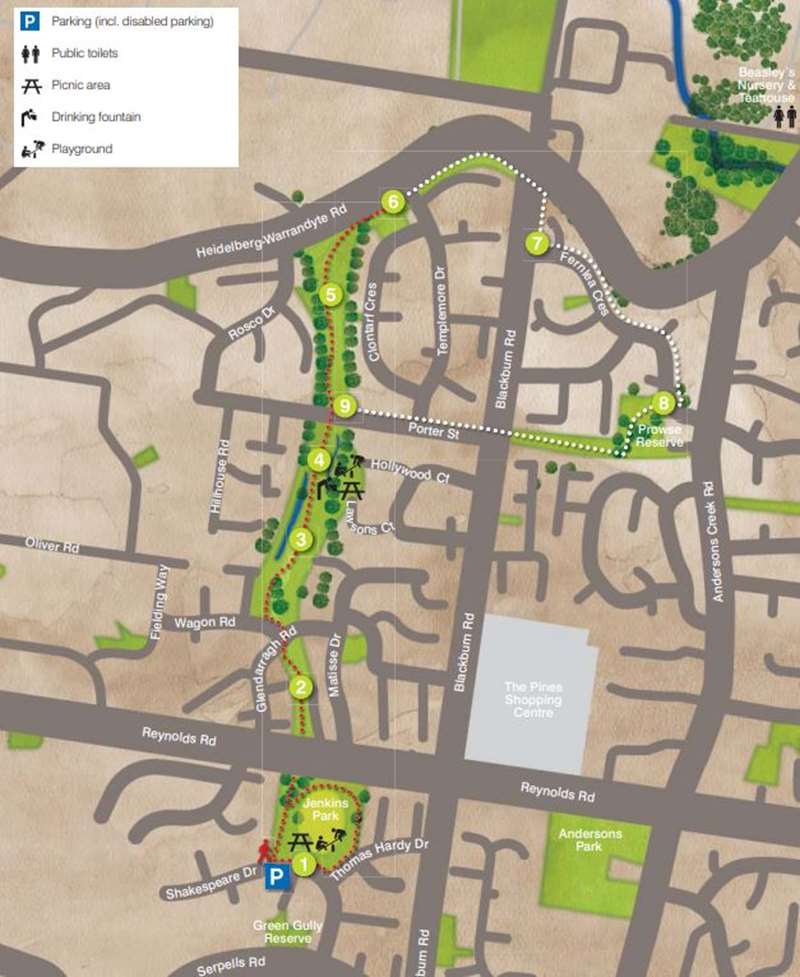Green Gully to Jenkins Park Walk (Templestowe)

-embed01.jpg)
This is an easy walk that is simple to follow, beautiful to be on and offers plenty of interest. There is an extension walk to consider if this light and easy walk is not enough.
.jpg)
The walk which is 3.8 km (or 5.4 km with an extension walk), begins at Jenkins Park, a small oval shaped reserve with a slight rise. The walk circles the little hillock then heads through an underpass into a narrow green belt to the first of two street crossings. The next section is past wetlands, with visiting wader-birds and the sounds of frogs into the final stage, which is a wide expanse of open park boasting lorikeets and the occasional galah. The walk then rises and falls to Warrandyte Road where you can collect your breath and return via the same route.
There is an extension walk that loops you through the neighbourhood.
Facilities are a playground, drinking fountain and toilets.
Map of Route

Route Description
Your walk begins at Jenkins Park. There is a playground, water toilets and toilets here. This is a 3.8 km return track that can be shortened depending upon your level of fitness. Simply turn around at any point and return. There are plenty of rest spots so take your time.
Head off to your right to circle the park.
1. The view from the small rise is worth stopping for. Much of Templestowe was cleared for farming or orchards. These practices exposed hillsides and reduced habitat for wildlife. It also provided wonderful views. Orchards were the mainstay of many Templestowe and Doncaster families. Nearby, Petty's Orchard (Homestead Road, open Fridays) and Aumann's Orchard (Harris Gully Road, open every day) offer you fruit from old established fruit trees all year round.
Continue along the track through the underpass under Reynolds Road.
2. There are several trees along this stretch that are a favourite with the Rainbow Lorikeets. Rainbow Lorikeets are noisy parrots with vibrantly coloured plumage. They chatter in small to extremely large groups all vying for native nectar, pollen and flowers that dominate their diet. You will see them in eucalypts, melaleucas and banksias in Green Gully and neighbouring streets - they can't be ignored! They are so attention grabbing that they were the first Australian parrot the early Europeans chose to illustrate in colour in 1774.
Cross Glendarragh Road.
3. This stretch of green can be muddy underfoot. This is associated with naturally occurring wetlands. To your left is a remnant vegetation zone that is connected to the gully's wetlands. There is a little tributary that flows over and under this land and keeps the area seasonally boggy. Wetlands are a critical part of our natural environment and quite common in gullies. They reduce the impact of floods, absorb pollutants and improve overall water quality. They also provide habitat for animals and plants. Here in Green Gully you might see waderbirds including native ducks and herons.
4. There is a picnic shelter, drinking fountain and playground if you would like a break. Cross the bridge over the tributary. This is where you might hear the occasional frog, particularly in spring and summer.
At Porter Street cross through post and rail fencing that reminds us of the area's previous farming use. There is a bin here.
5. Narrow green belts like these connect wildlife corridors throughout Melbourne. They provide avenues for possums, gliders, koalas, kangaroos and birds to pass without having to navigate overhead powerlines here or housing. Ironically these areas are often preserved because of powerlines. As electrical towers began to connect our suburbs, towns and cities, areas around these large intrusive objects were kept clear of urbanisation. This created kilometres of greenery, which now is being allowed to regenerate back to its native state.
Walk up and over the hill and through the small bushland. At the bottom of the path there is a bus stop if you need to catch your breath before the return.
6. Extension Walk
A loop that takes you through neighbourhood streets and parks to rejoin Green Gully at Porter Street. This is a medium rated walk and unsuitable for strollers.
Please ensure that you use pedestrian crossings where they are offered. From the end of your Green Gully walk, cross Templemore Drive and continue on the footpath along Warrandyte Road. Cross Blackburn Road at the designated pedestrian crossing and turn right, then left into Fernlea Crescent (7). You are looking for an opening to Prowse Reserve (8). It is just before Anderson Creek Road. Turn right and take the little bush track to a wide grassy reserve and turn right. It is now an uphill walk, but with good views from the top. Take care in crossing Blackburn Road - there are no pedestrian crossings at hand. Walk down Porter Street to Green Gully where you turn left (9) and retrace your steps back to Jenkins Park.
This finishes your walk. Time to relax and plan your next adventure.
Access for Dogs:
The walk between points 1 and 5 on the map is a dog off-leash area (part of Green Gully Trail). The extension walk is a dog on-leash area.
Photos:
Location
26 Shakespeare Drive, Templestowe 3106 View Map
Web Links
→ Green Gully to Jenkins Park Walk Guide and Map (PDF)









